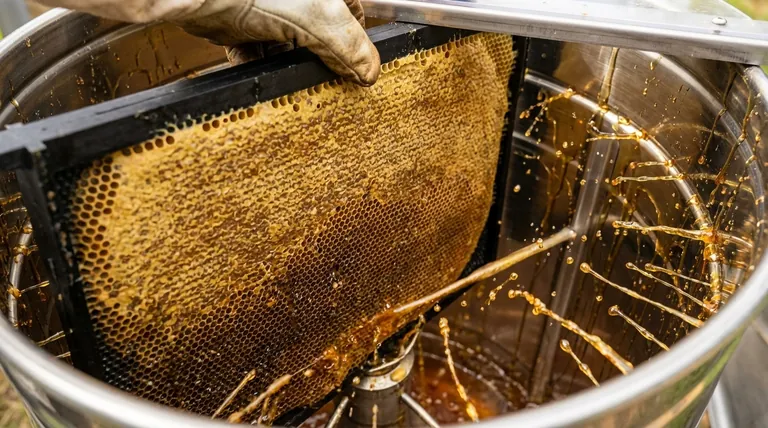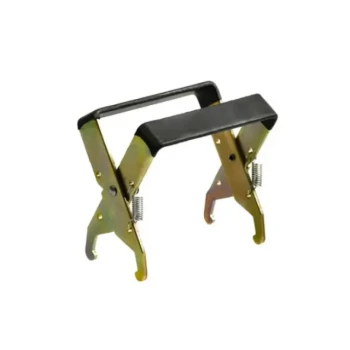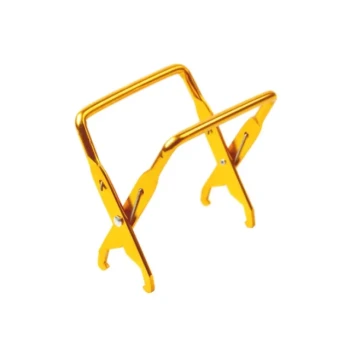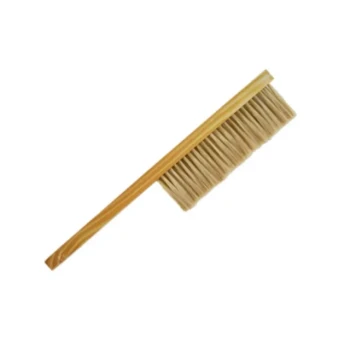For honey supers intended for extraction, the definitive and most reliable choice is plastic foundation. This rigid internal support is specifically designed to withstand the immense forces generated during mechanical extraction, preventing the catastrophic failure of your honeycomb and ensuring a successful, efficient harvest.
The decision of which foundation to use—or whether to use any at all—is a direct trade-off between the durability required for extraction and the desire for completely natural comb. For extraction, durability is paramount.

Why Extraction Puts Your Comb at Risk
To understand the need for foundation, you must first appreciate the physics of the extraction process. It's a violent, high-speed operation that places extreme stress on a delicate natural structure.
The Force of Extraction
A honey extractor works by using centrifugal force. As the frames spin, the heavy honey is slung outward against the walls of the drum, while the lighter beeswax comb remains in the frame.
This outward force pulls the entire sheet of honeycomb away from the frame's center. Without a rigid backbone, this force is often too much for the wax to handle.
The Weakness of Natural Wax
Honeycomb is an engineering marvel, but it's built for vertical, static loads. It is not designed to resist the shearing, tearing forces generated by high-speed spinning.
When a heavy, uncapped frame of honey is spun, an unsupported wax comb can easily tear, stretch, or completely disintegrate—an event beekeepers call a "blowout."
The Role of Foundation in Preventing Breakage
Foundation provides the internal skeleton that allows honeycomb to survive the extraction process. The choice of material, however, directly impacts its effectiveness.
Plastic Foundation: The Standard for Durability
Plastic foundation is the industry standard for extracted honey production. It is a single, rigid sheet of food-grade plastic that provides unyielding support to the entire comb.
Because the beeswax is drawn out directly on this solid surface, it is impossible for the comb to tear away during extraction. This allows you to spin the frames at high speeds, extracting honey quickly and completely without fear of comb breakage.
Foundationless Frames: A High-Risk Alternative
It is possible to have bees build comb in frames with no foundation at all. This results in beautiful, pure beeswax comb.
However, foundationless frames lack any internal support. They are exceptionally fragile and pose a significant risk of disintegrating in an extractor. While some beekeepers manage to extract from them, it requires extreme care.
Understanding the Trade-offs
Choosing between these methods involves weighing reliability against other beekeeping goals. There is no single "best" answer, only the best choice for your specific objective.
The Case for Plastic Foundation
The primary benefit of plastic foundation is reliability. You can operate your extractor with confidence, knowing your frames will emerge intact and ready to be returned to the hive for the bees to refill.
The main drawback is that bees can sometimes be slower to build out comb on plastic compared to pure wax. Furthermore, some beekeepers prefer to avoid having plastic components in their hive.
The Risks of Extracting Foundationless Comb
The benefit of foundationless comb is that it is 100% natural beeswax, which may be desirable for certain products like cut comb honey.
The significant drawback is the high probability of destroying the comb in the extractor. Success requires a very slow extraction speed and careful handling, which is inefficient and still not guaranteed. For a beginner, the risk of a messy, wasteful failure is very high.
Making the Right Choice for Your Goal
Your decision should be guided by your primary objective for the harvest.
- If your primary focus is a reliable and efficient honey harvest: Use plastic foundation. It is the safest, most dependable method for ensuring your combs survive extraction.
- If your primary focus is producing all-natural comb and you accept the risk: You can attempt to extract foundationless frames, but you must do so on the slowest possible speed and be prepared for potential comb loss.
Choosing the right equipment for the job is the first step toward a rewarding and successful honey harvest.
Summary Table:
| Foundation Type | Best For | Key Benefit | Main Risk |
|---|---|---|---|
| Plastic Foundation | Reliable Honey Extraction | Prevents comb breakage from centrifugal force | Slower comb draw by bees |
| Foundationless Frames | All-Natural Comb Honey | 100% pure beeswax comb | High risk of comb destruction in extractor |
Achieve a reliable, high-yield honey harvest with the right equipment from HONESTBEE.
As a wholesale supplier to commercial apiaries and beekeeping equipment distributors, we provide the durable, high-performance foundations and supers built to withstand the rigors of mechanical extraction. Protect your investment and maximize your efficiency.
Contact HONESTBEE today to discuss your commercial beekeeping supply needs.
Visual Guide

Related Products
- Food Grade Plastic bee Foundation for Bee Frames
- Plastic Hand Crank 2 Frame Honey Extractor Low Price
- HONESTBEE 6 Frame Three Use Electric Honey Extractor for Beekeeping
- HONESTBEE 72 Frame Industrial Electric Honey Extractor for Beekeeping
- Manual Beeswax Comb Foundation Machine Wax Foundation Mill Embossing Machine
People Also Ask
- What additional step can improve the performance of plastic foundation in the hive? Apply a Generous Coat of Beeswax
- Does plastic foundation affect honey quality or taste? A Practical Guide for Beekeepers
- Why do commercial beekeepers prefer plastic foundation? Durable, Reusable, and Cost-Effective
- What is a plastic foundation sheet? A Durable, Reusable Hive Management Solution
- How to get bees to use plastic foundation? Master the Wax Coating and Resource Strategy



















